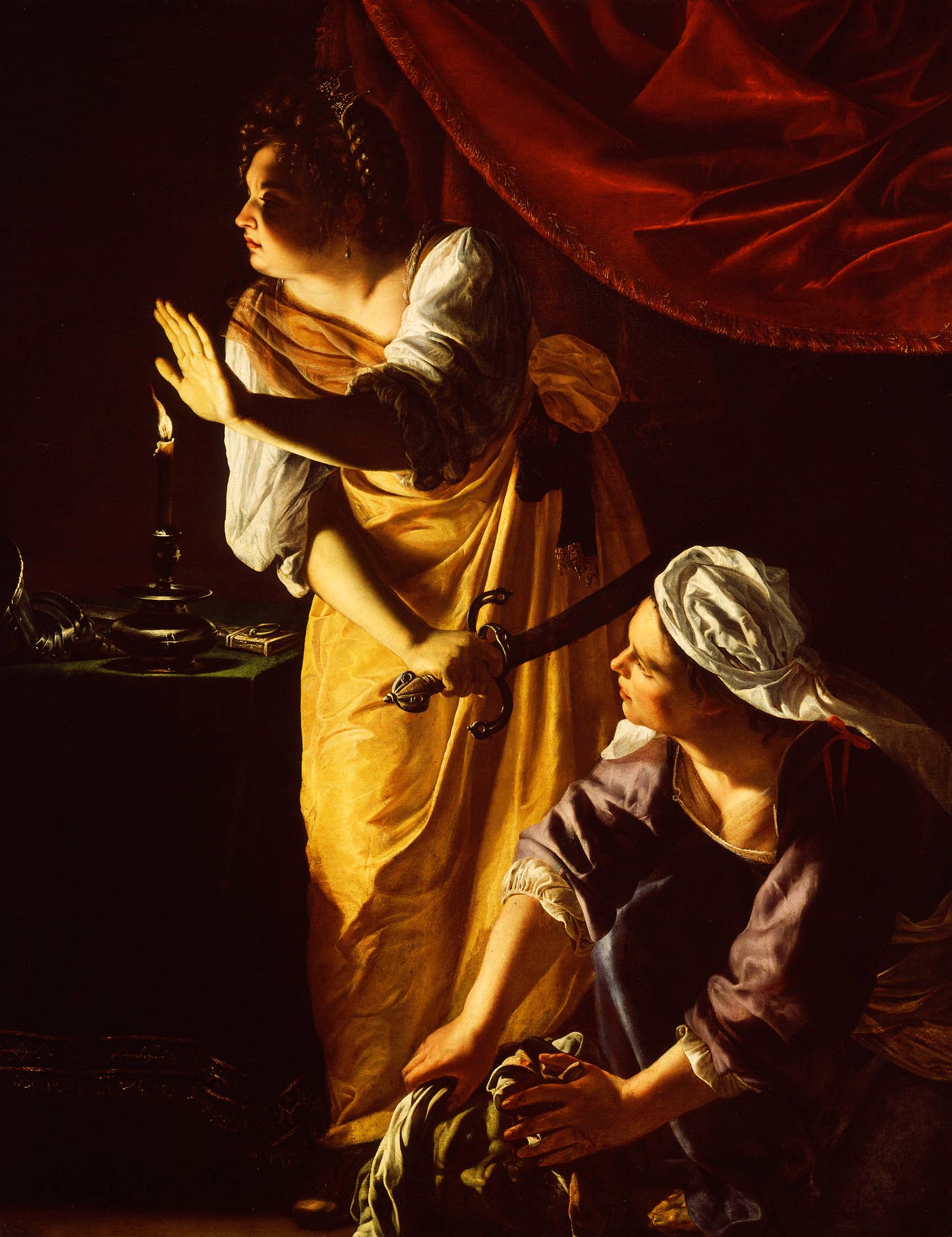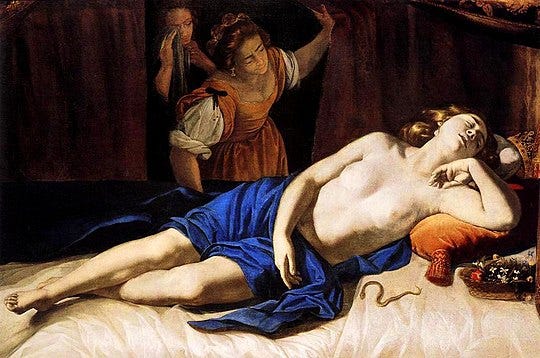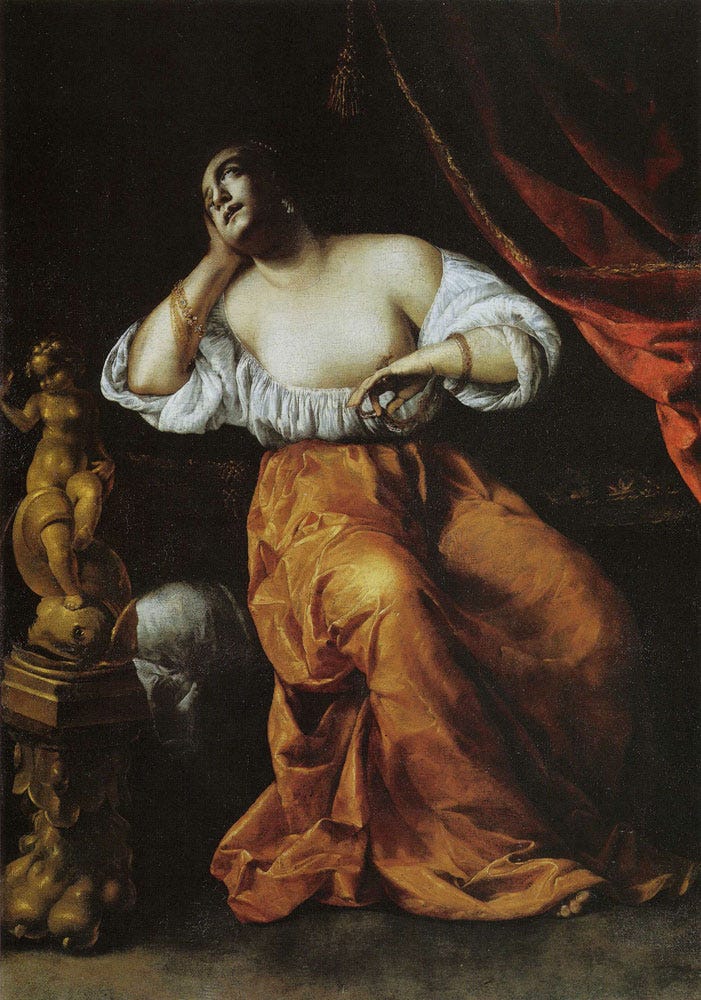Artemisia Gentileschi (1593–1653) is celebrated as one of the most important painters of the Italian Baroque and a pioneering female artist whose life and work continue to resonate with modern audiences. Known for her dramatic compositions, powerful use of light and shadow, and nuanced portrayals of female protagonists, she broke new ground in a male-dominated art world. Deeply influenced by Caravaggio’s revolutionary techniques, his masterful chiaroscuro and naturalistic realism, Artemisia transformed personal trauma into art that speaks of resilience, justice, and empowerment.
Born in Rome in 1593 to the painter Orazio Gentileschi, Artemisia was introduced early to the rigorous artistic traditions of her time. Denied formal academy training due to her gender, she honed her skills in her father’s workshop by copying drawings and learning to mix pigments. Immersed in Rome’s vibrant art scene, she absorbed Caravaggio’s bold compositions and his uncanny ability to capture raw human emotion, which instilled in her a desire to depict stories of struggle and defiance (Garrard 35–52; Haskell 120–135).



Artemisia’s oeuvre is distinguished by its intense realism and dramatic composition. Her celebrated painting, Judith Slaying Holofernes (c. 1612–13), exists in several versions and is perhaps her most famous work. In it, she portrays the biblical heroine with visceral power, using stark contrasts of light and dark to confront the viewer with themes of violence, vengeance, and female empowerment. Equally significant is Susanna and the Elders (1610), which reinterprets a well-known narrative with psychological acuity that challenges the traditional, objectified portrayal of its subject (Garrard 105–125). Other notable works include Self-Portrait as the Allegory of Painting, in which she boldly asserts her identity as a professional artist, and Cleopatra, underscoring her recurring interest in powerful female figures. These works demonstrate not only her technical mastery but also her ability to infuse historical and biblical narratives with personal significance.

A pivotal and tragic chapter in Artemisia’s life was her rape by Agostino Tassi in 1612; a traumatic event that led to a sensational trial. Documented in legal records and later analyzed by art historians, the trial exposed the deep-seated gender biases of early seventeenth-century Italy. Rather than silencing her, this ordeal fueled Artemisia’s determination to depict the struggles and strength of women. Scholars such as Catherine Puglisi argue that the raw emotional power and unflinching realism in works like Judith Slaying Holofernes are intimately linked to her personal experience of injustice, transforming her trauma into a defiant artistic statement (Puglisi 89–102). This personal history not only humanized her subjects but imbued her art with a unique urgency and authenticity that continues to captivate modern audiences.
Beyond her technical brilliance and dramatic storytelling, Artemisia Gentileschi has emerged as a feminist icon. In an era when female voices were systematically silenced, she boldly claimed her space in a male-dominated world, not merely by excelling in her craft but by channeling her personal pain into a powerful narrative of resistance and empowerment. Feminist scholars, notably Mary D. Garrard, have reinterpreted Artemisia’s work as a defiant reclamation of female subjectivity and agency (Garrard). Her depictions of strong, determined women in scenes such as Judith Slaying Holofernes resonate with modern audiences, inspiring contemporary feminist art and sparking renewed debate on gender, power, and representation in art history. As new exhibitions and critical studies continue to bring her legacy to the forefront, Artemisia’s art stands as both a testament to her personal courage and a rallying cry for female empowerment across generations (Schapiro; Langdon).

During her lifetime, Artemisia secured prestigious commissions and exhibited her work in prominent venues. Today, institutions such as the National Gallery in London and The Metropolitan Museum of Art feature her paintings, affirming her significance in art history (National Gallery; The Met). Posthumously, her legacy was revived by feminist scholars and art historians who positioned her as a proto-feminist trailblazer. Modern reassessments emphasize that her art, with its uncompromising portrayal of strength amid adversity, continues to inspire debates on gender, power, and identity in both historical and contemporary contexts.


Artemisia Gentileschi’s life and work represent a powerful fusion of personal experience, technical mastery, and social commentary. From her early training under the influence of Caravaggio to her bold reinterpretations of biblical narratives and the transformation of personal trauma into art, she redefined what it meant to be a female artist in the Baroque period. Her enduring legacy as a symbol of resilience and feminist empowerment challenges us to confront historical oppression and to celebrate the transformative power of creativity. As modern scholars continue to reexamine her contributions, Artemisia remains a beacon of artistic genius and a role model for generations of women.
References:
Garrard, Mary D. Artemisia Gentileschi: The Image of the Female Hero in Italian Baroque Art. Pennsylvania State University Press, 1989.
Haskell, Barbara. Art and Ideas in Italy, 1350–1660. Yale University Press, 2003.
Langdon, Helen. Caravaggio: A Life. Farrar, Straus and Giroux, 2012.
National Gallery. Artemisia Gentileschi. National Gallery, London, www.nationalgallery.org.uk/artists/artemisia-gentileschi. Accessed 14 Jan. 2025.
Puglisi, Catherine. Rewriting Trauma: The Trial of Artemisia Gentileschi and Its Impact on Her Art. Journal of Early Modern Studies, vol. 11, no. 1, 2012, pp. 89–102.
Schapiro, Meyer. The Age of the Baroque. Harper & Row, 1962.
The Metropolitan Museum of Art. Artemisia Gentileschi (1593–1653). The Met, www.metmuseum.org/toah/hd/gent/hd_gent.htm. Accessed 14 Jan. 2025.




The real kick in the face was when Tassi was found guilty of rape, only after Gentilischi was forced to testify with thumbscrews to test the honesty of her testimony. Then Tassi got off with a light sentence that he never even bothered to serve. No wonder she was angry, but managed to channel that anger to create magnificent art.
I am just astounded by this! I feel so ignorant sometimes when I discover new facts about feminists and their history. I believe the bracelet is a symbol but can’t even begin to wonder what kind when I am new to this knowledge. Is it our own interpretation? I feel, naively, that an artist wouldn’t paint anything for no reason. Thank you 💙👩🏻🦳👏🏻